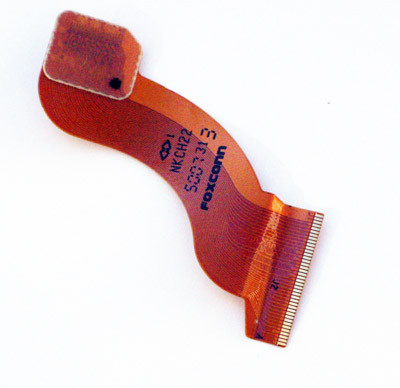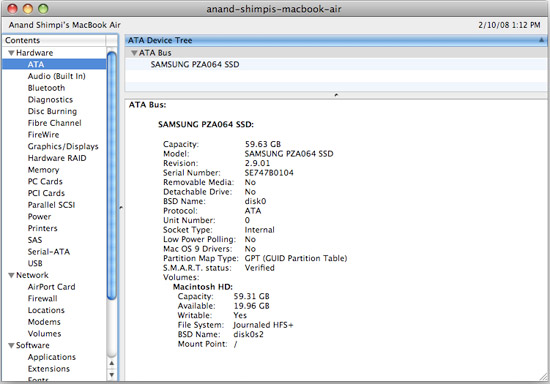The MacBook Air: Thoroughly Reviewed
by Anand Lal Shimpi on February 13, 2008 12:00 AM EST- Posted in
- Mac
The SSD Discussion
Apple inadvertently mitigated some of the dangers and annoyances of a mechanical hard disk in the Air by going with a 1.8" drive. These drives are used in the iPod and are designed to be rugged, cool and quiet. Because we're comparing an already low power, quiet drive to the SSD many of the advantages of the SSD just aren't as noticeable.
One aspect of SSD performance that isn't often talked about is that performance doesn't change as the drive gets fuller. Mechanical disk drives are designed to write to the outer most sectors first (where read speed is the fastest) and the inner most sectors last (where read speed is the slowest). When your drive is mostly empty, everything gets written to the fast part of the disk. As it gets full, data is written to the slower parts and thus you get degraded performance. The same doesn't apply to a SSD, since we're just writing to flash; performance is the same regardless of what part of the flash you're reading from.
If money were no object and we had to make a recommendation today, we'd still take the SSD over the mechanical drive. It is more responsive in the areas that bothered us the most when using the Air, it increases battery life by a good 14% on average and most importantly - it lowers the risk of a drive failure while on the road. The first stipulation of that recommendation is the one that's worth paying attention to: if money were no object.
Apple charges a hefty $999 for the 64GB SSD option, and on a $1799 notebook that's not insignificant; we're talking 55% of the price of a standard MacBook Air just for a drive swap. Apple isn't making that much profit on the drive either. The 64GB Samsung SSD Apple uses in the Air costs around $760, Apple actually makes more from the 200MHz CPU upgrade than the $999 SSD.
The beauty of solid state storage is that it's based on Flash, whose prices are directly influenced by Moore's Law. We've been told that within 3 months you can expect the cost of these 64GB SSDs to drop by around 30%, so we'd be looking at around $530 for the same drive in the near term. Obviously we're talking about cost here, if we apply the same 28% markup Apple currently uses on the SSD option to the new price we get around $680 for the SSD upgrade in 3 months. There's no guarantee that Apple will pass on the savings but if they don't, you can always shop around for the drive from another vendor such as DVNation.
Price isn't the only thing that will improve with time: performance will as well. When the transition to solid state disks first started happening the controllers (the chip that sits between the PATA/SATA interface and the Flash memory) were hardly optimized for performance. Because performance was so poor, the first SSDs were used for industrial applications where the ruggedness of the drives were most important and performance didn't really matter.
As controller technology advanced, so did performance but since the SSD market was still small the manufacturers had to pick and choose their battles. The natural fit for higher performance drives was the 2.5" SATA SSD market, after all these drives would be going into expensive notebooks. Controller development for PATA drives just wasn't as far along and thus PATA SSD offerings generally lagged behind in performance compared to their SATA counterparts.

The ZIF connector, it's bendy
In order to maintain the slim form factor of the Air, Apple stuck with a PATA interface for the hard drive; this isn't your grandmother's 44-pin PATA connector, it's a 40-pin low profile, ZIF (Zero Insertion Force) ribbon connector. There is no SATA equivalent so if you want to build a very small device you need to rely on a PATA drive, which is exactly what Apple did. Unfortunately, it also means that the $999 SSD Apple uses isn't the fastest SSD in the world - the 2.5" models are much quicker.
What about Smaller SSDs?
While the 64GB drive used in the Air is fairly expensive today, you can find cheaper 32GB drives on the market. The cost to manufacture the 32GB version is exactly 50% so the retail price ends up being about half as well. The problem is that 32GB isn't enough space for an often used OS X machine.
The default install of OS X and all of its applications that ship with the Air eats up close to 20GB of space; add a few necessities like Microsoft Office or Photoshop, not to mention copying DVDs/movies to your hard drive to watch them unless you want to lug around the external DVD drive as well and you'll quickly run out of space on a 32GB drive.

Ouch, only 19.96GB free? Hurry up Moore, we need larger SSDs.
When we were done installing all of the applications and test files needed for our benchmarks on the 64GB SSD we only had 19.96GB available. That's more than enough if you never install another application or copy any large content over, but chances are that won't happen.
Your best bet is honestly sticking with the 80GB PATA drive (unless money really isn't an object in which case just buy the SSD now and buy a larger one later) and upgrading to a 64GB or larger SSD when they are available.










41 Comments
View All Comments
sprockkets - Wednesday, February 13, 2008 - link
I don't get it. I can use my Pioneer laptop slot loading burner on an external enclosure and it be powered solely via the one usb port and works just fine, even while writing to dvds.For that matter, I can do the same with notebook laptop drives. Rarely do I need both usb ports connected in order for it to work.
sprockkets - Wednesday, February 13, 2008 - link
Only about 16mbits per second on the xfer rate on wireless? Wow. Were you using n?JarredWalton - Thursday, February 14, 2008 - link
I don't know what Anand used, but I've seen everything from 3MBps to 12MBps on an 802.11n network... all with laptops in the same room, and many using the same chipset (Intel 4965AGN). Overall, N tends to feel about half as fast as 100Mbit Ethernet - or about twice as fast as 802.11G. Router choice unfortunately still has a major influence on 802.11N performance.Imaginer - Wednesday, February 13, 2008 - link
It is what the overall feel and message of the article indicates to me. It is a bit expensive, non-expansive, lacks most utility to be used in most mobile situations, and it is purely for computing on the bare minimum.Kind of like that so called weekend car. I don't think I myself will have ANY need for such a device. Give me a powerful desktop and a versitle yet remaining non cumbersome notebook anyday.
Most people in the market for a laptop usually would use it like their normal away from home computer and because of this, the air really disappoints. (not that I would invest in a new computer anytime soon).
jedmitchell - Wednesday, February 13, 2008 - link
hey, so good review overall -- kept it very even handed considering the difficulty of reviewing a niche product like this. one hardware point I'd like to mention though is the info you give on the X3100. certainly the idea behind it is that as an integrated controller it won't provide very fast graphics, but there's a trick here: most of the things it's not rated to run... run. at least on the older macBook (santa rosa). final cut pro, maya, and photoshop actually all run pretty seamlessly on the X3100, both in OSX and windows (fcp is more memory/drive limited there than GPU). the only small problems are in windows where the X3100 drivers by intel are actually lacking several openGL 2.0 features present in apple's version.the X3100 even plays older games on windows without much trouble -- I can run the Orange Box games at 1024x768 with high quality settings and see a fairly regular 30fps, less a few texture memory glitches. anyway, it would be interesting to see how that performance in the same chipset scales from the macBook to the air.
jdwango - Wednesday, February 13, 2008 - link
However I wish you had also tried to install Windows XP/Vista via boot camp and reported your thoughts.joey2264 - Wednesday, February 13, 2008 - link
This would be a fairly good review if you would just mention the fact that most of the sacrifices Apple made to create the Macbook Air simply weren't necessary. If you look like at a notebook like the Fujitsu Lifebook S6510 of the Lenovo X300 this becomes clear. Looking at these two notebooks, it is obvious that each of the manufacturers could have come up with a 13.3 in, 1 spindle notebook that didn't make hardly any other compromises (decent keyboard, decent port selection, replaceable battery, upgradeable memory, standard 2.5" hard drives (Lenovo could have probably fit a 2.5" hard drive in there if they had used a 13.3" screen, with the requisite larger footprint, although it would have been a little heavier), etc).michael2k - Wednesday, February 13, 2008 - link
The S6510 you mention is heavier (by a pound) and nearly twice as thick! It is much more comparable to a MacBook (5 pounds and an inch thick vs 4 pounds and 1.42 inches thick).The X300 is also not available yet, so a comparison will have to wait until we find out about price and build quality.
mlambert890 - Thursday, February 14, 2008 - link
OK, so then the Sony TX, the Fujitsu P7k, the Toshiba Portege, the Dialogue Flybook, the Panasonic Toughbook, the Dell XPS1210, the Sony SZ, The LG XNote....There's a pretty long list of notes that are smaller and ligher or as light or slightly heavier with a lot more features than the MBA.
The MBA is THINNER. Last I checked thinner is a BS feature. When someone can explain to me WHY thinner means ANYTHING beyond looking cool at Starbucks, maybe Ill be interested.
The Sony X505 was pretty much the same situation as the MBA except it had a removable battery and more ports and that was 3 years ago. I think the MBA was like .2" thinner than the Sony *at its thinnest point* and about the same at the thickest.
The MBA is big news for the cult of Mac which lately is including PC sites like this.
michael2k - Friday, February 15, 2008 - link
Fujitsu P7230: Too slow (one core at 1.2GHz vs two cores at 1.6GHz), half as much ram (1GB vs 2GB) for the same priceDell XPS 1330: You can't get a 1210 from Dell.com (one pound (33%)heavier) for 2/3 the price
Sony TZ250N: You can't get a TX from Sonystyle.com, too slow (2 cores at 1.2GHz vs 1.6Ghz), too expensive ($600 more)
Sony SZ750N: Too big and heavy (1 pound (33%) heavier and twice as thick) for the same price
You argue against thinner: Thinner is only a measure of weight. Compare to 3 pounds (2.7 to 3.2 pound) and you already eliminate the toughbook, the Dells, the Portege, and the SZ. Compare to the CPU speed and you eliminate the Fujitsu and Sony TZ.
So what is left? The Lenovo X300, which is still more expensive, but for that extra expense you get an optical drive.